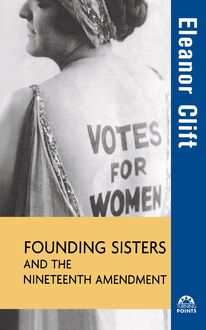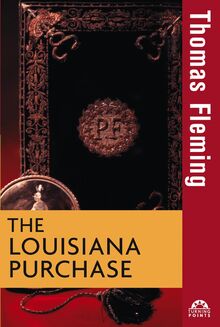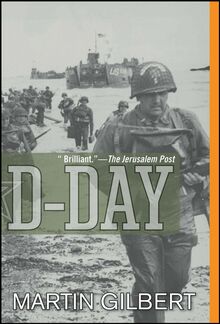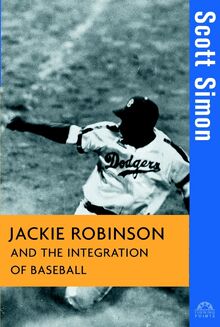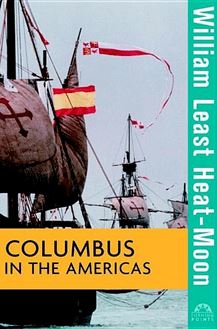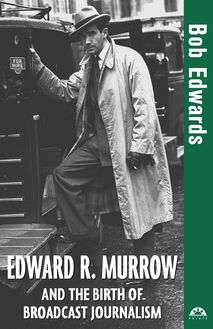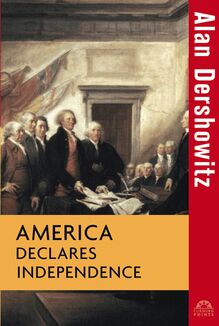Founding Sisters and the Nineteenth Amendment , livre ebook
84
pages
English
Ebooks
2007
Vous pourrez modifier la taille du texte de cet ouvrage
Obtenez un accès à la bibliothèque pour le consulter en ligne En savoir plus
Découvre YouScribe en t'inscrivant gratuitement
Découvre YouScribe en t'inscrivant gratuitement
84
pages
English
Ebooks
2007
Vous pourrez modifier la taille du texte de cet ouvrage
Obtenez un accès à la bibliothèque pour le consulter en ligne En savoir plus
Publié par
Date de parution
24 août 2007
Nombre de lectures
2
EAN13
9780470256152
Langue
English
In this riveting account, political analyst Eleanor Clift chronicles the many thrilling twists and turns of the suffrage struggle and shows how the issues and arguments that surrounded the movement still reverberate today. Beginning with the Seneca Falls Woman’s Rights Convention of 1848, Clift introduces the movement’s leaders, recounts the marches and demonstrations, and profiles the opposition—antisuffragists, both men and women, who would do anything to stop women from getting the vote.
Founding Sisters and the Nineteenth Amendment mines the many rich stories buried deep within this tumultuous period of our history. Here, Clift reveals how:
- Opposition came not only from men, but also from women who were afraid of losing the special protection they enjoyed as the"weaker sex." It wasn’t until the United States was preparing to enter World War I to defend democracy around the world that denying women the vote became indefensible.
- Frail and beautiful Inez Milholland Boissevain died campaigning for suffrage and became a martyr to the movement. Her death spurred protests in front of the White House, to the embarrassment of President Wilson.
- The president directed the mass arrests of these peacefully picketing suffragists, and they endured miserable prison conditions that horrified the nation.
- Race divided the suffrage leaders. Frederick Douglass played a crucial role during the early suffrage meetings—and later was betrayed by Susan B. Anthony.
- Elizabeth Cady Stanton had a penchant for "bloomers" as a symbol of women’s independence—a risky fashion statement that backfired.
A stirring reminder for women to never take their rights for granted, Founding Sisters and the Nineteenth Amendment profiles the brave figures who spent their lives supporting the women’s movement over the course of seventy-two years.
Acknowledgments.
Introduction.
1. Stirrings of Discontent.
2. "Aint't I A Woman".
3. Testing the Limits.
4. Passing the Torch.
5. Division in the Ranks.
6. Martyr for the Cause.
7. Out of Bondage.
8. A Vote for Mother.
Epilogue.
Bibliography.
Publié par
Date de parution
24 août 2007
Nombre de lectures
2
EAN13
9780470256152
Langue
English
Founding Sisters
and the Nineteenth Amendment
Preeminent writers offering fresh, personal
perspectives on the defining events of our time
Published Titles
William Least Heat-Moon, Columbus in the Americas
Scott Simon, Jackie Robinson and
the Integration of Baseball
Alan Dershowitz, America Declares Independence
Thomas Fleming, The Louisiana Purchase
Forthcoming Titles
Douglas Brinkley on the March on Washington
William F. Buckley Jr. on the Fall of the Berlin Wall
Bob Edwards on Edward Murrow and
the Birth of Broadcast Journalism
Sir Martin Gilbert on D-Day
Martin Goldsmith on the Beatles Coming to America
Founding Sisters
and the Nineteenth Amendment
E LEANOR C LIFT
John Wiley & Sons, Inc.
Copyright © 2003 by Eleanor Clift. All rights reserved
Published by John Wiley & Sons, Inc., Hoboken, New Jersey
Published simultaneously in Canada
Design and production by Navta Associates, Inc.
No part of this publication may be reproduced, stored in a retrieval system, or transmitted in any form or by any means, electronic, mechanical, photocopying, recording, scanning, or otherwise, except as permitted under Section 107 or 108 of the 1976 United States Copyright Act, without either the prior written permission of the Publisher, or authorization through payment of the appropriate per-copy fee to the Copyright Clearance Center, 222 Rosewood Drive, Danvers, MA 01923, (978) 750-8400, fax (978) 750-4470, or on the web at www.copyright.com . Requests to the Publisher for permission should be addressed to the Permissions Department, John Wiley & Sons, Inc., 111 River Street, Hoboken, NJ 07030, (201) 748-6011, fax (201) 748-6008, e-mail: permcoordinator@wiley.com.
Limit of Liability/Disclaimer of Warranty: While the publisher and the author have used their best efforts in preparing this book, they make no representations or warranties with respect to the accuracy or completeness of the contents of this book and specifically disclaim any implied warranties of merchantability or fitness for a particular purpose. No warranty may be created or extended by sales representatives or written sales materials. The advice and strategies contained herein may not be suitable for your situation. You should consult with a professional where appropriate. Neither the publisher nor the author shall be liable for any loss of profit or any other commercial damages, including but not limited to special, incidental, consequential, or other damages.
For general information about our other products and services, please contact our Customer Care Department within the United States at (800) 762-2974, outside the United States at (317) 572-3993 or fax (317) 572-4002.
Library of Congress Cataloging-in-Publication Data:
Clift, Eleanor, date.
Founding sisters and the Nineteenth Amendment / Eleanor Clift.
p. cm.
Includes bibliographical references.
ISBN 0-471-42612-1
1. Women—Suffrage—United States—History. 2. Suffragists—United States—History. I. Title.
JK1896.C55 2003
324.6'23'092273—dc21
2003011761
Printed in the United States of America
10 9 8 7 6 5 4 3 2 1
Contents
Acknowledgments
Introduction
1. Stirrings of Discontent
2. “Ain’t I a Woman?”
3. Testing the Limits
4. Passing the Torch
5. Division in the Ranks
6. Martyr for the Cause
7. Out of Bondage
8. A Vote for Mother
Epilogue
Bibliography
Acknowledgments
I want to thank the people who guided me through the research for this project. Karen O’Connor, the founder of the Women & Politics Institute at American University, handed me a jumbo storage container filled with books about the suffrage movement, a fraction of the library she has accumulated since being told as a grade schooler that there were no great women leaders. Ann Lewis, a longtime political activist who helped elect Hillary Clinton to the U.S. Senate and who works with the Democratic National Committee to develop women leaders, shared her extensive collection of suffrage writings and memorabilia, along with her wisdom and homemade bread. Brian McLaughlin, reference librarian for the U.S. Senate, unearthed “The Olivia Letters,” a collection of writings by journalist Emily Briggs that describe in witty and colorful language the encounters between suffrage leaders and official Washington in the post-Civil War period. Visiting the Sewall-Belmont House on Capitol Hill, where Alice Paul once lived, allowed me to summon up the ghosts of the suffragists as I pored through the yellowed newspaper clippings documenting their struggle. Executive Director Angela Gilchrist and Woman’s Party head Marty Langlen welcomed this project, and librarian Jennifer Spencer put just the right books and articles into my hands. Allida Black and Marjorie Lightman, who serve on the Sewall-Belmont Scholars Committee, were generous with their time and advice, as was Jean Baker, a professor of history at Goucher College.
I consulted many books. Two stand out because they provided the road map for the seventy-two-year suffrage struggle. They are Not for Ourselves Alone: The Story of Elizabeth Cady Stanton and Susan B. Anthony, which accompanied the Ken Burns documentary on these two women, and A History of the American Suffragist, by Doris Weatherford, published on the 150th anniversary of the convention at Seneca Falls. The books I relied on to enrich the detail around pivotal events and people are: The Story of Alice Paul and the National Woman’s Party, by Inez Haynes Irwin; Jailed for Freedom, by Doris Stevens; and The Perfect 36: Tennessee Delivers Woman Suffrage by Carol Lynn Yellin and Janann Sherman. John Roberts’s seminal new work on the political influence of first ladies arrived while I was writing and proved a valuable resource for historical context and sweep. His Rating the First Ladies: The Women Who Influence the Presidency is a serious treatment of a role traditionally undervalued. My goal was to construct a narrative that has the immediacy of contemporary events. If I succeeded, it is because I was able to build on the foundation laid by these and other authors.
Finally, I want to thank my editor, Stephen S. Power, who invited me to undertake this project, and my husband, Tom Brazaitis, who is my first and most faithful reader.
Introduction
Helen Thomas encouraged me to write this book. A media icon whose long career spans nine presidents, Thomas started in journalism writing radio copy during World War II. When the war was over and the men returned home, women were expected to give up their jobs and go back to tending house. Thomas loved the workplace and eventually became the equal of any man as one of the longest-serving and best-known White House correspondents. We were on a panel not long ago speaking to high school students, and Thomas urged the girls never to take their rights for granted. She told them the suffragists marched for thirty years before women got the vote, and that Susan B. Anthony and others were jailed for daring to demand access to the ballot box. “And these are rights we should have been born with,” she concluded with gusto. The girls listened wide-eyed as though happening upon this piece of history for the first time. They couldn’t imagine a time when women weren’t allowed to vote. “Young women today think this all just dropped from the sky,” Thomas said with a sigh. “They have no idea how long women struggled.”
The Founding Sisters must have been smiling when ten-year-old Mindy Tucker announced with great conviction to her classmates that a woman could be president. Her fifth-grade teacher in Texas, Mr. Clodfelter, a fearsome presence in the classroom, found the assertion so preposterous that at the next parent-teacher conference, he asked the girl’s mother where she might have gotten such an outlandish notion. It was 1980, and girls were not encouraged to think of themselves as future presidents. Tucker’s mother told him it was her idea. Divorced and with a career of her own, she set the example for her daughter. The next decades brought visible progress for women in all the professions, including politics. By the dawn of the twenty-first century, the prospect of a woman president no longer seemed radical or ridiculous, and girls were increasingly brought up to think of themselves as leaders in the society in addition to homemakers. Tucker became the first female spokesperson at the Justice Department, a job she landed after working in George W. Bush’s presidential campaign. She laughs when she recounts her grade-school experience. It seems so remote and unconnected to American life today, when women take their place along with men as senators, Supreme Court justices, presidential advisers, and presidential candidates.
First lady Edith Wilson was among those who found the suffragists “disgusting creatures.” She did not hide her disdain for the societal disruption they represented. Yet her reverence for tradition did not stop her from taking over her husband’s duties after he suffered a disabling stroke, making her the most powerful woman ever to live in the White House, while at the same time concealing the true nature of her husband’s impairment. She probably saw it less as seizing power than protecting her husband’s image, which would fall within the wifely sphere. Women were fearful that suffrage would topple them from their pedestal and thrust them into competition with men for which they were not suited. They worried that by claiming equality they would lose the special protections they enjoyed as the weaker sex. This argument was revisited in more recent times when writer Nora Ephron quipped that the most enduring legacy of the feminist movement was the Dutch treat.
Women are not equal in every respect to men; there are still battles to be fought. But a girl born today begins her journey with an equal sense of possibility for the future. Women are the crown jewel of the electorate. Politicians co
